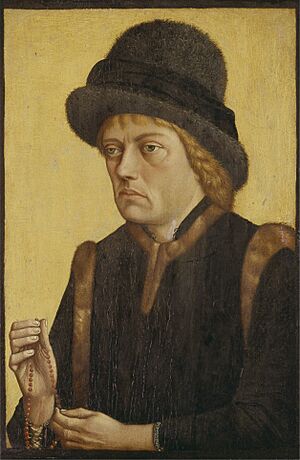Sigismund, Archduke of Austria facts for kids
Quick facts for kids Sigismund |
|
|---|---|
| Archduke of Austria | |

Portrait by the Master of the Mornauer Portrait, circa 1470 (Alte Pinakothek, Munich)
|
|
| Born | 26 October 1427 Innsbruck, Tyrol |
| Died | 4 March 1496 (aged 68) Innsbruck |
| Burial | Stams Abbey |
| Spouse | Eleanor of Scotland Catherine of Saxony |
| House | House of Habsburg |
| Father | Frederick IV, Duke of Austria |
| Mother | Anna of Brunswick-Lüneburg |
Sigismund (born October 26, 1427 – died March 4, 1496) was an important ruler from the House of Habsburg. He was a Duke of Austria starting in 1439. Later, in 1477, he became an Archduke, which was a higher title.
Sigismund ruled over areas like Further Austria and the County of Tyrol. He was in charge from 1446 until he stepped down in 1490.
Contents
Early Life and Becoming a Ruler
Sigismund was born in Innsbruck, a city in Tyrol. His father was Duke Frederick IV of Austria. His mother was Anna of Brunswick-Lüneburg.
When Sigismund's father died in 1439, Sigismund was still a child. His cousin, Frederick V, became his guardian. Frederick V was also the King of the Romans. He looked after Sigismund's lands until 1446.
Frederick wanted to control more land. He even got involved in the Old Zürich War. This was to try and get back lands the Habsburgs had lost to the Swiss. But the nobles in Tyrol wanted Sigismund to rule his own lands.
Taking Control of His Lands
In 1446, Sigismund finally became the ruler of his own territories. These included Further Austria. This area had lands in Swabia, like the Sundgau in Alsace and the Breisgau.
Sigismund was supposed to marry a French princess named Radegonde. But she passed away in 1445. So, in 1449, Sigismund married Princess Eleanor of Scotland. She was the daughter of King James I.
Sigismund gained more land in 1451, including parts of Vorarlberg. However, he had disagreements with his cousin's brother, Archduke Albert VI. Sigismund had to give up some lands to Albert for a while.
Disputes and Excommunication
For much of his rule, Sigismund argued with Nicholas of Cusa. Nicholas was a powerful church leader, a Prince-bishop and a Cardinal. They fought over control of valleys in Tyrol.
Sigismund even marched his army against Nicholas's castle in 1460. Because of this, Pope Pius II removed Sigismund from the Catholic Church. This is called being "excommunicated." Nicholas later died in 1464. Sigismund eventually made peace with the Pope.
Changes in Land and Money
In 1469, Sigismund sold some of his lands near the Rhine river. These included parts of Alsace and the Breisgau. He sold them to Charles the Bold, the Duke of Burgundy. It's not fully clear why he sold them. Some say it was because he had many debts from his expensive lifestyle. Others think he wanted Charles to protect these lands from the growing Swiss Confederacy.
Sigismund also bought more land in Vorarlberg. He bought the County of Sonnenberg in 1474. He then joined forces with the Swiss and cities in Alsace. Together, they fought against Charles the Bold in the Battle of Héricourt.
Becoming Archduke and New Marriages
In 1477, Sigismund's cousin Frederick, who was now the Holy Roman Emperor, gave him a higher title. Sigismund became an Archduke.
Princess Eleanor, Sigismund's first wife, died in 1480. In 1484, Sigismund married again. His new wife was 16-year-old Catherine of Saxony. She was the daughter of Duke Albert III. Sigismund did not have any children from either marriage.
The Coinage Reform
In the late 1470s and early 1480s, Sigismund made a big change to money. He created a new, large silver coin called the guldengroschen. This was one of the first large silver coins in a very long time. Later, this coin led to the creation of the thaler, which is the ancestor of many modern coins, including the US dollar.
New ways of mining helped bring silver mines in Tyrol back to life. Soon, other areas started making similar large coins. This led to a huge increase in coin production. Because of these money changes, Sigismund was sometimes called der Münzreiche. This means "rich in coin."
Later Years and Legacy
Sigismund sometimes listened to bad advice from his advisors. In 1487, he started a war with the Republic of Venice. This was called the War of Rovereto.
Tyrolean soldiers quickly took over silver mines that belonged to Venice. Sigismund also upset Venice by putting 130 Venetian merchants in prison. He took their goods too. Tyrol attacked the Pass of Calliano. They also used a huge cannon called a bombard to attack a castle. This was one of the first times such a large cannon was used in battle. The war ended without a clear winner.
By 1490, nobles in Tyrol wanted Sigismund to step down. He handed over his rule to Archduke Maximilian. Maximilian was Frederick's son and later became Holy Roman Emperor. It's not fully clear if Sigismund gave up power willingly or if he was pressured to do so.
When Sigismund died in 1496, his branch of the Habsburg family ended. Archduke Maximilian became the sole heir to all the family's lands.
Images for kids
See also
- Burgundy Wars
- Sigmundskron Castle



